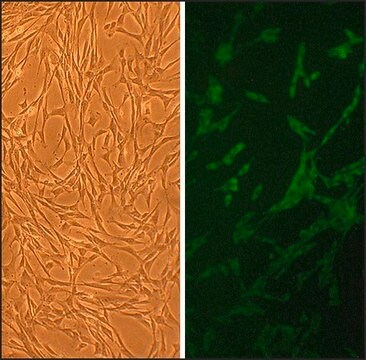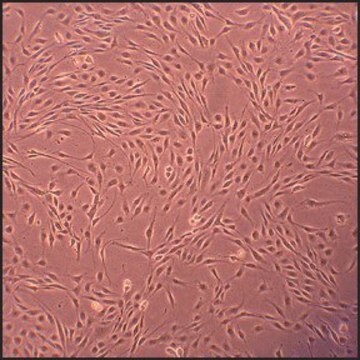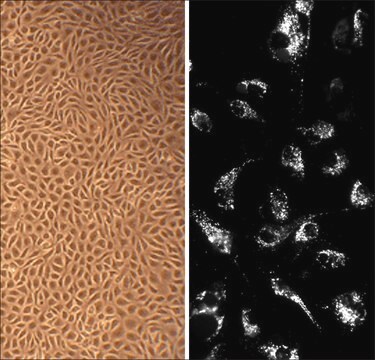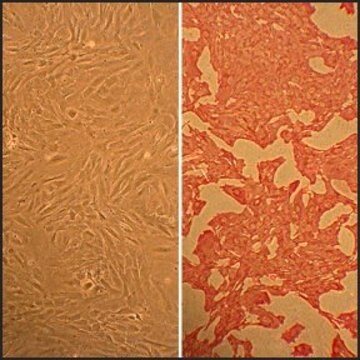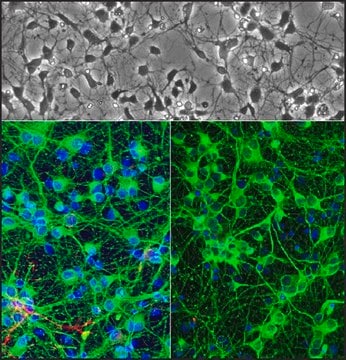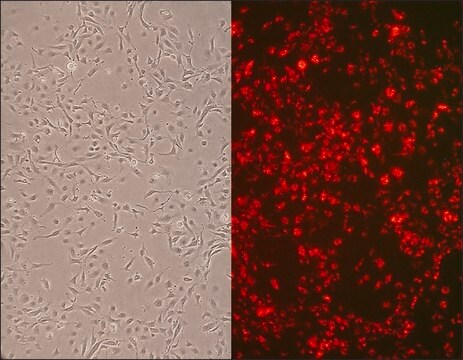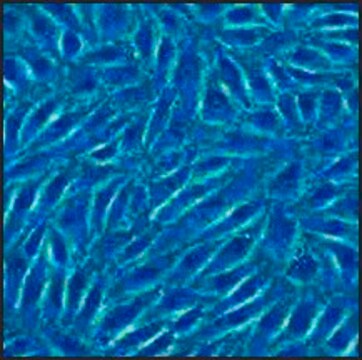CN354-05
Komórki mięśni gładkich aorty psów: CnAOSMC (Cryovial)
About This Item
Polecane produkty
pochodzenie biologiczne
canine aorta (normal, tunica intima and media)
opakowanie
pkg of 500,000 cells
producent / nazwa handlowa
Cell Applications, Inc
tryb wzrostu
Adherent
kariotyp
2n = 78
morfologia
smooth muscle
metody
cell culture | mammalian: suitable
powiązane choroby
cardiovascular diseases
Warunki transportu
dry ice
temp. przechowywania
−196°C
Opis ogólny
Komórki mięśni gładkich aorty psów (CnAOSMC) pochodzą z błony wewnętrznej i środkowej prawidłowej aorty psów. Są one kriokonserwowane przy drugim przejściu i mogą być hodowane i rozmnażane przez co najmniej 10 podwojeń populacji. Płytkowy czynnik wzrostu (PDGF) jest silnym mitogenem i czynnikiem chemotaktycznym, który może być zaangażowany w hiperplazję błony wewnętrznej i miażdżycę. Wykazano, że istnieją znaczne różnice regionalne w produkcji PDGF w prawidłowej aorcie psów, a SMC są istotnym czynnikiem przyczyniającym się do regionalnych różnic w produkcji PDGF.
1. Wykazano również, że nebiwolol rozluźnia mięśnie gładkie naczyń krwionośnych poprzez mechanizmy zależne od NO i cyklicznego GMP.
2. SMCs przeszczepu są funkcjonalnie zmienione, wytwarzając więcej płytkopochodnego czynnika wzrostu (PDGF) niż SMCs aorty. PDGF wytwarzany przez SMCs przeszczepu może przyczyniać się do rozwoju hiperplazji błony wewnętrznej.
3. SMCs przeszczepu mają zmniejszoną odpowiedź proliferacyjną, ale mają podobną odpowiedź migracyjną na PDGF w porównaniu z SMCs aorty.
4.Wewnętrzne różnice w komórkach śródbłonka z aorty proksymalnej w porównaniu z aortą dystalną mają różną zdolność do wytwarzania PDGF w odpowiedzi na stymulanty, podczas gdy niestymulowane SMC nie wykazywały regionalnych różnic w produkcji PDGF i nie zwiększały wydzielania PDGF po leczeniu PMA lub trombiną.
5.Identyfikacja cDNA dla psiej izoformy syntazy tlenku azotu (iNOS) może być wykorzystana w badaniu odrzucenia przeszczepu i chorób sercowo-naczyniowych.
RECENT PUBLICATIONS Kiyan, Y., S. Tkachuk, D. Hilfker-Kleiner, H. Haller, B. Fuhrman, and Inna Dumler. 2014. oxLDL indukuje odpowiedź zapalną w komórkach mięśni gładkich naczyń poprzez połączenie receptora urokinazy z CD36 i TLR4. J Molec and Cell Cardiol, 66: 72-82.
Ignarro, L.J. et al, Nitric Oxide. 7(2):75-82 (2002).
Madura, J.A. et al, J. Vas Res. 33(1):53-61 (1996).
Pitsch, R.J. et al, J. Vasc. Surg. 26(1):70-8 (1997).
Minion, D.J. et al, J. Vasc. Surg. 31(5):953-9 (2000).
Van Aalst, J.A. et al, J. Vasc. Surg. 32(3):584-92 (2000).
Wang, X. et al, Am. J. Physiol. 275(4 Pt 2):H1122-9 (1998).
Produkty są przeznaczone wyłącznie do użytku badawczego. Nie są przeznaczone do stosowania u ludzi, zwierząt ani do celów diagnostycznych.
Pochodzenie linii komórkowej
Zastosowanie
Komponenty
Uwaga dotycząca przygotowania
- 2. pasaż, >500 000 komórek w pożywce Canine Smooth Muscle Cell Basal Medium zawierającej 10% FBS i 10% DMSO
- Może być hodowany przez co najmniej 10 podwojeń
Rutyna subkultury
Kod klasy składowania
11 - Combustible Solids
Klasa zagrożenia wodnego (WGK)
WGK 3
Temperatura zapłonu (°F)
Not applicable
Temperatura zapłonu (°C)
Not applicable
Wybierz jedną z najnowszych wersji:
Certyfikaty analizy (CoA)
It looks like we've run into a problem, but you can still download Certificates of Analysis from our Dokumenty section.
Proszę o kontakt, jeśli potrzebna jest pomoc Obsługa Klienta
Masz już ten produkt?
Dokumenty związane z niedawno zakupionymi produktami zostały zamieszczone w Bibliotece dokumentów.
Protokoły
Technical information for working with Canine Aortic Smooth Muscle Cells including thawing, subculturing and cryopreservation
Nasz zespół naukowców ma doświadczenie we wszystkich obszarach badań, w tym w naukach przyrodniczych, materiałoznawstwie, syntezie chemicznej, chromatografii, analityce i wielu innych dziedzinach.
Skontaktuj się z zespołem ds. pomocy technicznej